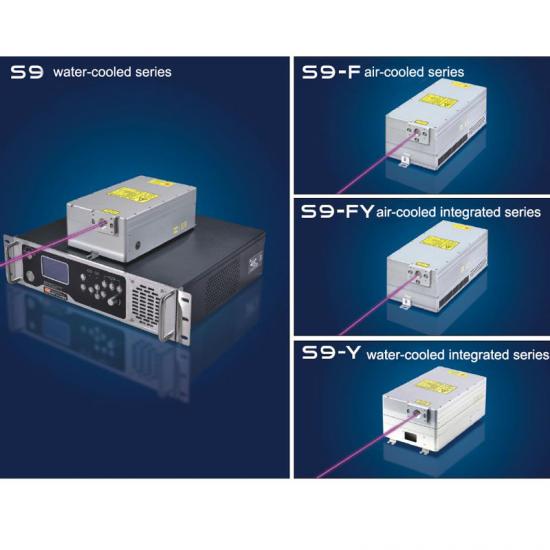UV 레이저란?
Apr 07 , 2022What is a UV Laser?
UV Laser or Ultraviolet Laser offer extremely high photon energy which opens up a wide range of applications that can’t be addressed by visible and infrared laser sources.
UV lasers use a highly absorptive wavelength (355 nm) to mark parts. This high absorption rate allows UV lasers to perform "cold marking," ensuring that no extra heat stress is applied to materials, including those with high reflectance such as gold, silver, and copper. This minimizes soot and burrs caused by typical marking and processing.
It’s important to point out that while 355 nm and 266 nm are the most common UV laser wavelengths, there are also several other Nd: YAG lines that can be doubled and tripled to produce a wide variety of UV wavelengths. To achieve these higher-order harmonics, the electric field density of the laser must be extremely high, as a result, these lasers are primarily available with q-switched lasers. Continuous-wave (CW) UV laser diodes are also available at 375 nm, with both single-mode and multi-mode beam profiles, and with either free space or fibre-coupled outputs. OEM laser packages and CW laser modules are available for both ultraviolet laser diodes and q-switched lasers.
Apart from real ultraviolet lasers, there are ultraviolet laser sources based on a laser with a longer wavelength (in the visible or near-infrared spectral region) and one or several nonlinear crystals for nonlinear frequency conversion. Some examples:
• The wavelength of 355 nm can be generated by frequency tripling the output of a 1064-nm Nd:YAG or Nd:YVO4 laser.
• 266-nm light is obtained with two subsequent frequency doublers, which in effect quadruple the laser frequency.
• Diode lasers can be equipped with nonlinear frequency conversion stages to produce UV light. For example, one may use a continuous-wave near-infrared laser and apply resonant frequency doubling twice, arriving at wavelengths around 300 nm. A main attraction of this approach is that a wide range of wavelengths is accessible, with no limitations to certain laser lines.

uv laser | green laser | Ultraviolet lasers | uv dpss laser | nanosecond laser | UV laser source | Solid State Lasers
How do UV Lasers Work?
By passing a standard wavelength laser (1064 nm) through a non-linear crystal, the wavelength is reduced to 532 nm. This light is further passed through another crystal, effectively reducing its wavelength to 355 nm. As a result, UV lasers are commonly called third-harmonic generation (THG) lasers.
Ultraviolet lasers need to be made with special ultraviolet optics, having a high optical quality and (particularly for pulsed lasers) a high resistance to UV light. In some cases, the lifetime of a UV laser is limited by the lifetime of the used optical elements such as laser mirrors. For the extreme ultraviolet region, there are sources based on high harmonic generation. Such sources can reach wavelengths down to a few nanometers while still having a table-top format. The average output powers, however, are fairly low.
Advantages of UV Laser
1. 표준 레이저 광(1064nm) 및 녹색 레이저 광(532nm)과 비교할 때 UV 레이저 광은 재료 흡수율이 현저히 높습니다. 즉, 눈에 잘 띄는 마크를 만들기 위해 출력을 높일 필요가 없습니다.
2. UV 레이저는 UV 광 흡수율이 높기 때문에 열 손상을 최소화하면서 금, 은, 구리와 같이 반사율이 높은 재료에 마킹할 수 있습니다. 이것은 그을음과 버를 최소화하고 표면 손상을 방지하며 부식 방지 마킹을 가능하게 합니다.
애플리케이션
자외선 레이저는 다양한 응용 분야를 찾습니다.
펄스형 고출력 자외선 레이저는 가시광선에 투명한 재료를 포함하여 다양한 재료에 작은 구멍을 효율적으로 절단하고 드릴링하는 데 사용할 수 있습니다.
고에너지 UV 펄스는 레이저 유도 파괴 분광법 기술에 사용됩니다.
정밀하게 초점을 맞춘 빔에서 펄스 에너지가 훨씬 낮기 때문에 예를 들어 현미경으로 생물학적 물질을 미세해부하거나 광발광 분석(형광 수명 측정)을 수행할 수 있습니다.
연속파 UV 소스는 마이크로 리소그래피 및 반도체 칩 제조와 같은 웨이퍼 검사에 필요합니다. 또 다른 응용 분야는 UV 라만 분광법입니다.
연속파 및 펄스 UV 레이저는 모두 광섬유 브래그 격자를 제작하는 데 사용됩니다.
눈 수술의 일부 방법, 특히 라식 형태의 각막 굴절 레이저 눈 수술에는 UV(때로는 심자외선) 레이저 소스가 필요합니다.
자외선 레이저 소스는 주로 눈 손상 및 피부암 유발 위험과 관련된 몇 가지 특별한 안전 위험을 수반합니다.